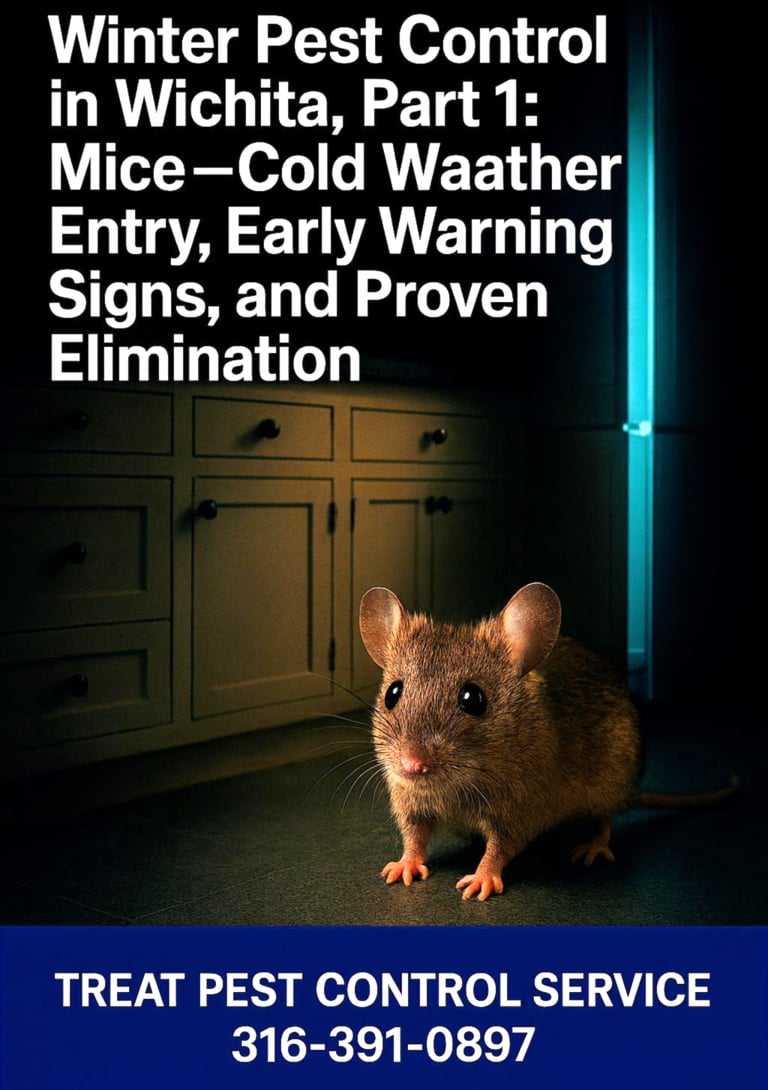Wichita Pest Control: Seal Entry Points for Mice cold weather driving mice inside
Is cold weather driving mice inside your home? Our expert team in Wichita & South-Central Kansas seals entry points, maps rodent activity, and eliminates mice using safe, targeted methods. Call us today at 316-391-0897 for effective pest control solutions.
Blaine M. Gales
10/24/20254 min read


Winter Pest Control in Wichita, Part 1: Mice—Cold Weather Entry, Early Warning Signs, and Proven Elimination
When temperatures drop in Wichita, Kansas, mice stop foraging outside and start looking for heat, food, and shelter inside homes, apartments, restaurants, food storage areas, and light industrial spaces. Winter makes your property more attractive than any field or hedgerow; warm utility chases, garage clutter, wall voids, and insulated attics quickly become safe nesting sites. A house or facility in Wichita can look “clean” and still support a growing mouse population because these rodents travel behind appliances, along sill plates, through expansion joints, and inside cabinets where activity is easy to miss. The problems escalate fast: food contamination, gnawed packaging, odor, insulation damage, and chewed wiring that can create real fire risk. If you manage a multi-unit building in Wichita or operate a small business on Kellogg, West Street, or in the Old Town corridor, winter rodent pressure is a given—not a surprise. What you do next determines whether the season stays quiet or turns into callbacks, complaints, and overtime.
Mice get in because buildings are perfect in theory but full of gaps in reality. A pencil-eraser opening under a door sweep is enough. So is a utility penetration that was never sealed, a garage weather-strip that shrank over time, or a cable pass-through that looked harmless when service was installed. In South-Central Kansas winds, these micro-gaps act like funnels, carrying scent and warm air outward while drawing rodents inward. Once inside, mice map the property in lines, not circles—baseboards, plumbing and electrical chases, joist bays, and the shadowed edges of storage. They favor quiet, consistent routes: toe-kicks beneath kitchen cabinets, the back line of pantry shelving, the space behind the refrigerator compressor, the gap at the garage slab where it meets framing, and the rim joist in basements. If you’re in a Wichita apartment or rental, the problem can spread through shared walls and chases even when one unit seems spotless, which is why building-level planning matters.
Early warning signs in real Wichita homes and businesses are subtle but reliable. Pepper-like droppings collect where traffic is heaviest—behind appliances, inside sink bases, and along the inside lip of cabinet frames. Shredded paper, pet hair, and fiber insulation appear in tucked-away corners as nesting material. A faint, musky odor builds in enclosed spaces. Light scratching at night becomes more frequent as populations grow and expand routes. In commercial or food environments, you might see tiny gnaw marks on bulk goods, pet food bags, or corrugated cases stacked on the floor. Seeing a mouse at noon usually means many were active at 2 a.m. The instinct to scatter snap traps or lay down repellent powders is understandable, but unplanned DIY tends to educate rodents and create avoidance without addressing the source—entry and harborages.
Professional winter mouse control in Wichita works because it treats the problem as a system: inspection, exclusion, targeted placements, sanitation, and verification. At Treat Pest Control Service (locally owned and family operated, fully licensed and insured), we begin with a light-in-the-hole inspection—outside first, then inside. We check door sweeps and thresholds that show daylight, weather-stripping that no longer seals, garage seals that tire where vehicles pass, utility penetrations for gas, electric, cable, and HVAC lines, and the common soffit and siding transitions where caulk has failed. We document every gap with photos and measurements so you can see exactly what is changing. Inside, we track runways with flashlights and monitors placed where mice actually travel: along sill plates, behind kick plates, inside cabinet corners, behind refrigerators and dishwashers, and in attic or crawl pathways. This mapping phase is critical in Wichita’s winter because it differentiates a new intrusion from a building-level issue that will recur unless the structure itself is tightened.
Exclusion is the foundation of long-term control in Kansas winters. We install and tune door sweeps that actually meet the floor, replace or realign weather-stripping, add escutcheon plates and sealants around utility penetrations, and use rodent-rated steel mesh and sealant at gaps that foam alone can’t secure. Garage and exterior service doors often need brush seals to close irregular concrete. If you manage a Wichita apartment community, we recommend a tiered approach—priority entry doors and trash enclosures first, then utility rooms and unit-level penetrations. In food or light industrial settings, dock doors, floor drains, and the base of framed partition walls get special attention. Exclusion doesn’t just keep mice out; it forces any remaining rodents inside to use predictable routes where targeted placements succeed quickly.
Once the structure is tightened, we apply targeted placements designed for efficiency and safety. In residential settings, we rely on skillfully set traps and locked, tamper-resistant stations in out-of-reach locations, chosen based on where activity is mapped—not guessed. In commercial and multi-unit buildings across Wichita, we combine locking stations along active runways with interior monitoring in safe, discreet locations that won’t interfere with operations. The placements are cleaned and serviced on a defined schedule, and we adjust based on data—replacing “hope” with measurable trend lines that show pressure dropping. We never broadcast rodenticides in living areas; instead, we keep chemistry secured and targeted while we remove the reasons mice want to be there.
Sanitation isn’t blame—it’s leverage. We help you make a few changes that have outsized impact during cold weather in Wichita, KS: elevate bulk goods and pet food off the floor, seal pantry staples, clean light oil films near ranges and dishwashers, and limit corrugated storage in warm areas where mice can hide and nest. In garages and shop spaces, we encourage enclosed bins, off-floor storage, and thoughtful placement of seasonal items so harborages are minimized. The goal is to reduce available calories and shelter so placements outcompete whatever the environment offers for free.
Verification closes the loop and creates peace of mind. You’ll receive a clear service plan with photos of exclusion work, a simple map of placements, and follow-up dates. For property managers and facilities in Wichita and South-Central Kansas, we provide audit-friendly notes and trend data so you can demonstrate control to owners or inspectors. If pressure changes due to construction nearby, a prolonged cold snap, or a new tenant introducing corrugated pallets, we adjust quickly rather than waiting for daytime sightings. That’s the difference between a winter that stays quiet and one that becomes an emergency.
If you’ve noticed droppings, heard nocturnal scratching, or spotted a mouse in daylight, it’s time to act before nesting and reproduction take hold. Treat Pest Control Service responds quickly across Wichita and the surrounding South-Central Kansas communities and travels statewide for portfolio commercial and industrial accounts. We align service to your setting—single-family homes, duplexes and apartments, restaurants, warehouses, or light manufacturing—and we stand behind the work with clear communication and professional follow-through. For a winter inspection and a plan that actually works, call 316-391-0897.
Your trusted partner in residential and commercial bug and pest control
MESSAGE US TODAY
© Treat Pest Control Service.
All rights reserved.


We accept:
PO BOX 780622
Wichita, KS 67278

